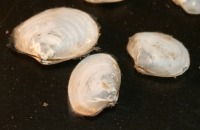
(Photo: Huntsman Marine Science Centre)
Fragile Spoonclam
Periploma fragile
Oval bivalve with the right shell valve more concave than the left. Can be up to 1.3 centimetres long. White with a finely wrinkled surface. Rounded anterior, and truncate (shortened) posterior.
Authority
Totten, 1835
Classification Details
Phylum: Mollusca (molluscs); Class: Bivalvia (bivalve molluscs).
Habitat
Found at depths of four to 128 metres in the Gulf of St. Lawrence and in estuaries.
Diet
Filter feeder. Sucks seawater from the surface of the seabed using its siphons. Then uses its gills to filter small food particles from the water.
Reproduction
Detail for this species not known to science. Bivalves can be male, female, or hermaphrodite (both male and female). Eggs develop into planktonic larvae that eventually settle on the seabed and change into adult clams.
Fun Facts
Scientists found this species at much lower densities inside the Passamaquoddy Bay Pockmarks than in the seabed around them. This might be due to them taking time to recolonize after being disturbed when the pockmarks formed.
References
Bernard FR, McKinnell SM and Jamieson GS (1991) Distribution and Zoogeography of the Bivalvia of the Eastern Pacific Ocean. Canadian Special Publication of Fisheries and Aquatic Sciences, no. 112, 60 pp. MolluscaBase (2020). MolluscaBase. Periploma fragile (Totten, 1835). Accessed through: World Register of Marine Species at: http://www.marinespecies.org/aphia.php?p=taxdetails&id=156939 Accessed online 22 January 2020. Morris PA, Abbott RT and Peterson RT (2001) A Field Guide to Shells: Atlantic and Gulf Coasts and the West Indies. Boston: Houghton Mifflin Harcourt. Palomares MLD and Pauly D (2019) Sealife Base. Periploma fragile (Totten, 1835) fragile spoonclam. https://www.sealifebase.ca/summary/Periploma-fragile.html Accessed online 22 January 2020.

